Pulao or pulav or pilaf, is comfort food at its best and I make it when I want to cook something quick, easy and satisfying. This one-pot dish made with fragrant rice and colorful healthy vegetables has added spices and herbs, giving it a mild fragrant flavor. This special veg pulao recipe is my mom’s and is my go-to recipe when making vegetable pulao. The dish is also vegetarian and is great on its own or paired with raita (an Indian yogurt dish), pickle and roasted papad (a crisp thin Indian snack).
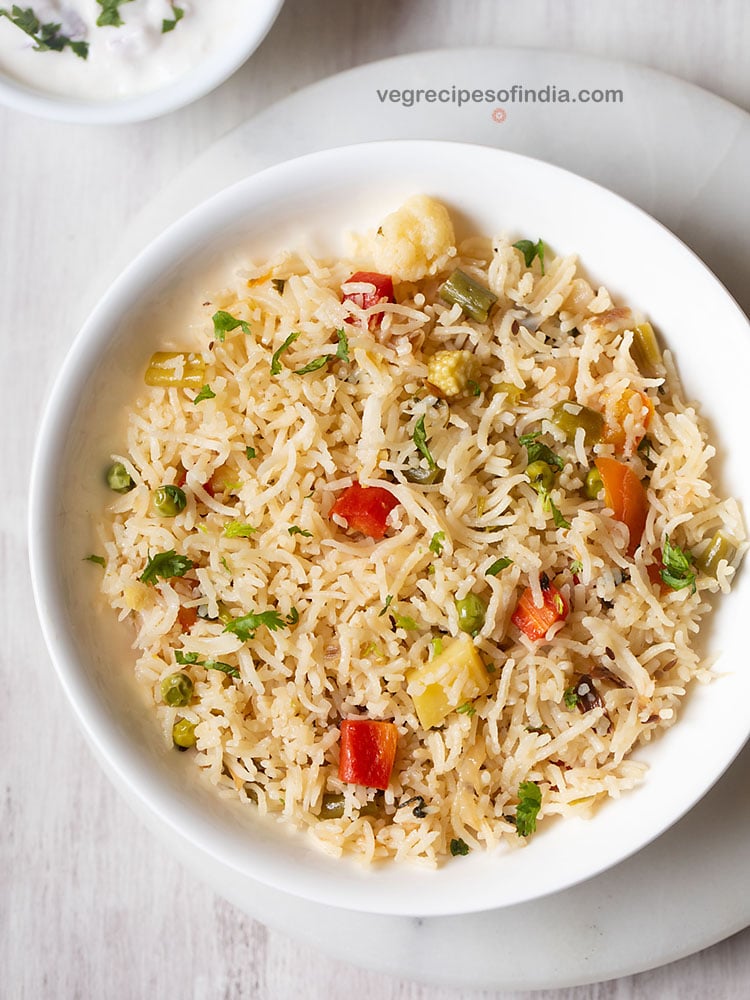
About Pulao
Called by various names such as pilaf or pulav, veg pulao is one of the most common vegetarian rice dishes in India, the other being Veg Biryani.
A pulao is a one pot dish of rice and vegetables or a protein cooked together with aromatics (onions, garlic, ginger etc), spices and herbs. There are many variations of making a pulav.
I have shared many different vegetarian pulao recipes on the blog including Peas Pulao, Kashmiri Pulao, Tawa Pulao, Paneer Pulao and more. However the recipe I share here is my favorite and how I almost always end up making it.
What I like about making veg pulao is that it comes together quickly. Use a food processor for chopping the veggies and it will really come together fast.
About This Veg Pulao
My recipe uses whole spices, rather than adding any pulao or biryani masala. Thus the fragrance of the spices is distinctly felt in the dish.
I usually like the texture of the rice to be a little soft in pulao, rather than being al dente, which is the way it is typically served in restaurants. So if you are like me, you will love this recipe. Read on below for tips on making the perfect rice for your pulao.
I usually add vegetables like carrots, green peas, french beans and cauliflower. But a pulao can be made with various other vegetables. Broccoli, beets, capsicum, spinach, cabbage, baby corn are some veggies that you can consider.
Usually pulao is made with the finest fragrant basmati rice. I mostly use aged basmati rice to make vegetable pulao. Other fragrant varieties of rice which are non-sticky also work well.
Pulao can be made in a pan on the stovetop, a pressure cooker or the Instant Pot. I like the rice grains to be fluffy and separate. So I cook the pulao in a pan on the stovetop.
If short of time you can consider making veg pulao in a stovetop pressure cooker or the Instant pot.
Do read on below in the tips section my helpful suggestions on making the perfect pulao for any occasion.
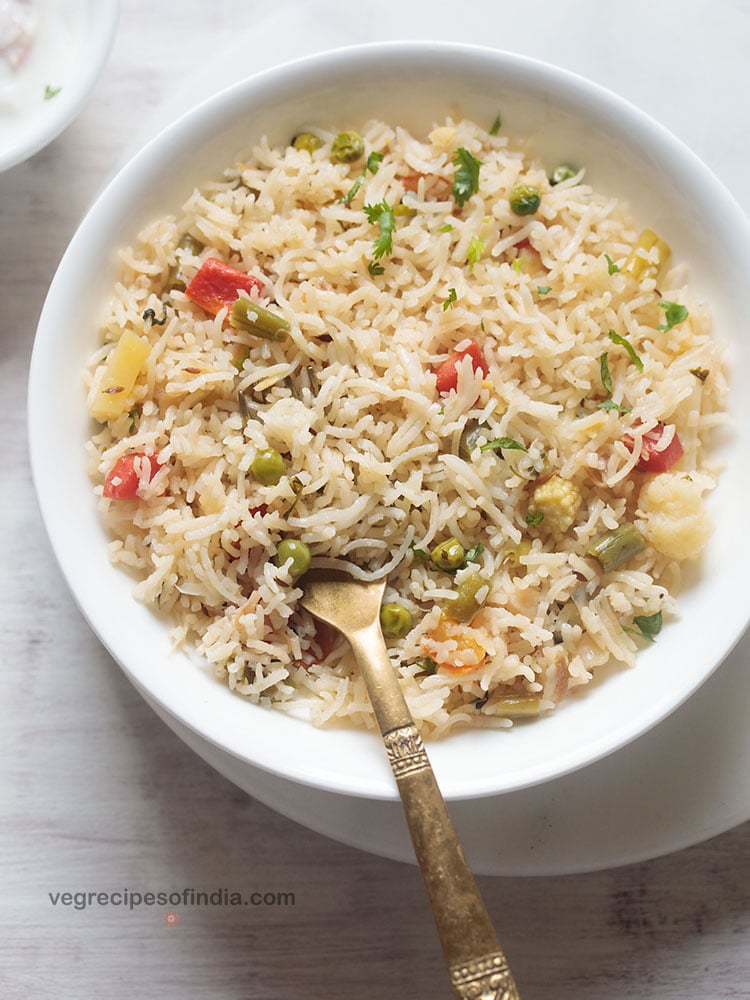
Step-by-Step Guide
How to make Veg Pulao
Preparation
1. Begin by rinsing 1.5 cups basmati rice in water until it runs clear of starch. Next, soak the rice in enough water for 20 to 30 minutes.
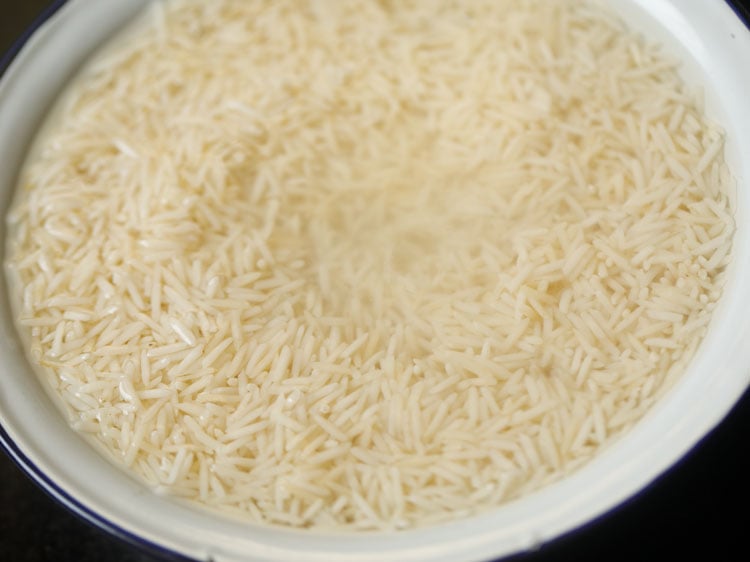
2. After 20 to 30 minutes strain the rice of all the water and keep aside.
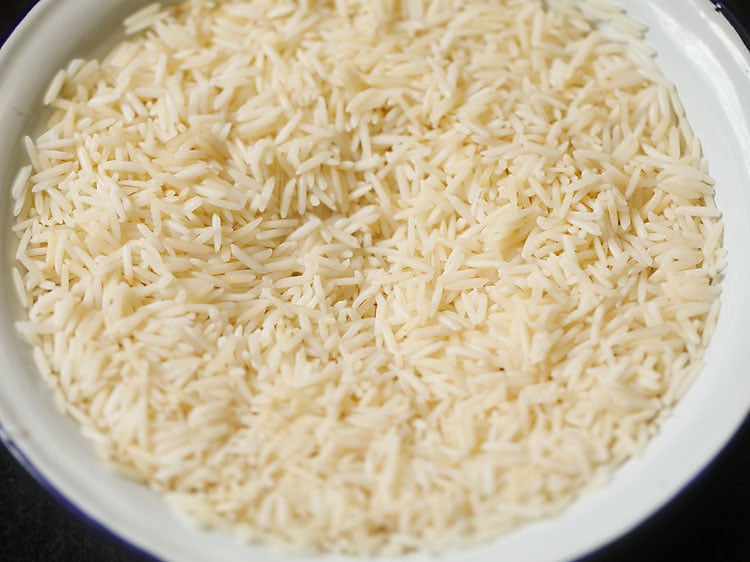
3. While the rice is soaking, prep the veggies. Rinse and chop them. Make sure to chop the vegetables in small cubes.
For cauliflower, chop them in medium-sized florets. Peel, rinse and slice 1 large onion thinly. You will need about 1.5 to 2 cups of chopped vegetables excluding the green peas, tomatoes and onions.
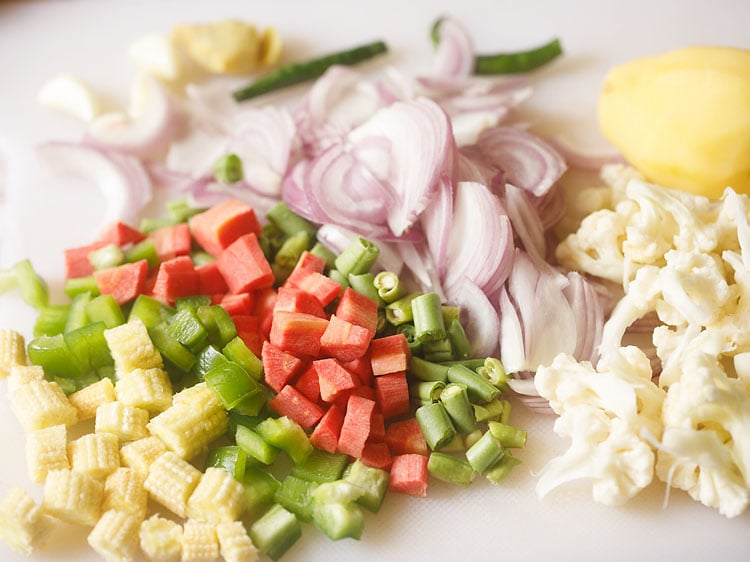
4. Keep all the whole spices aside. From the below list of spices, you can skip black peppercorns, black cardamom, star anise and mace.
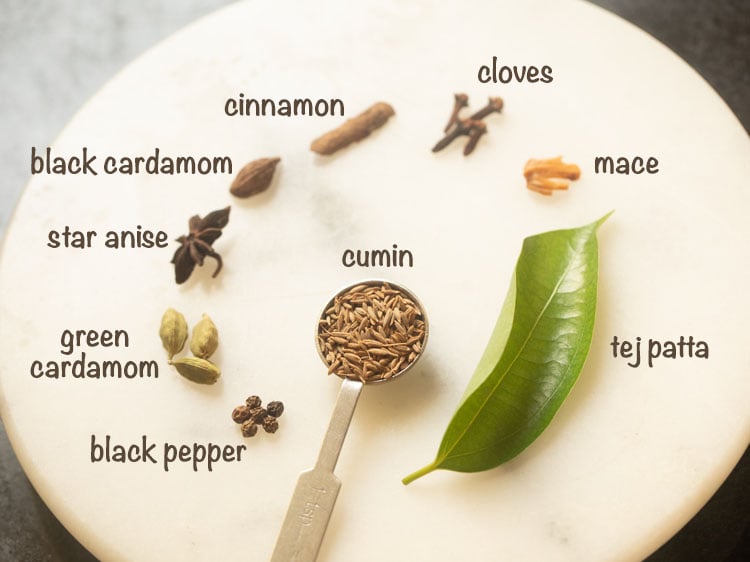
5. Add roughly chopped ginger (1 to 1.5 inches), garlic (4 to 5 small to medium garlic cloves, peeled) and 1 to 2 green chilies (green peppers) in a mortar-pestle.
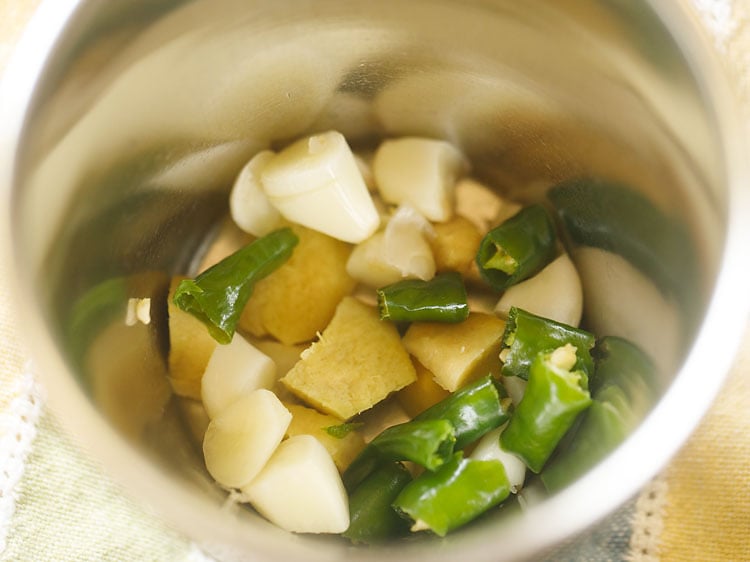
6. Crush to a paste. You can also use a small grinder for crushing these. Add a bit of water if required while grinding in a small grinder or mixer.
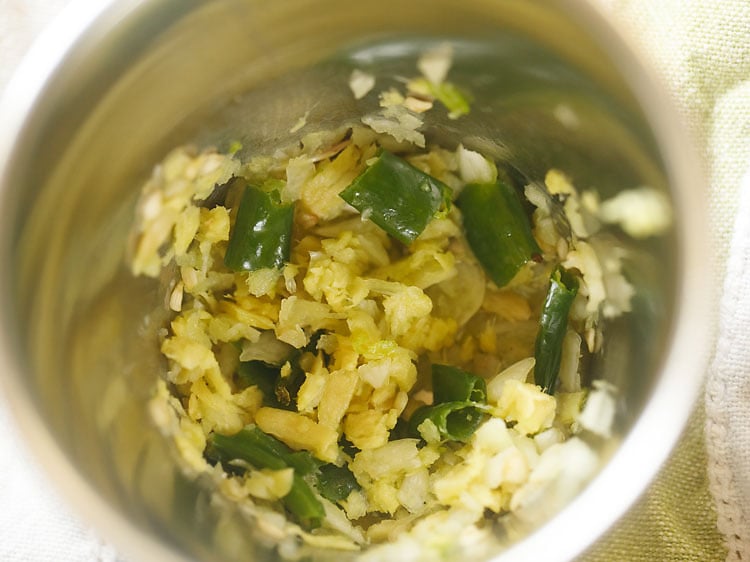
Make Vegetable Pulao
7. Heat 3 tablespoons ghee or oil in a deep thick bottomed pot or pan.
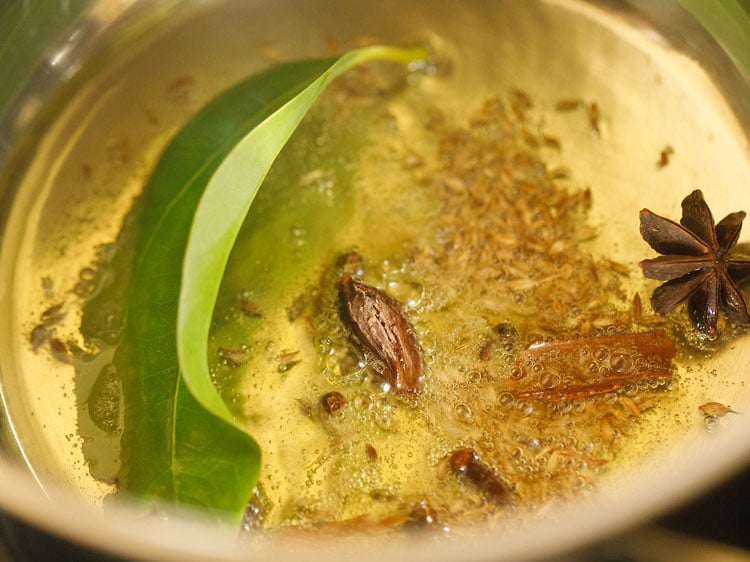
8. Once the ghee has melted and become hot, add all whole spices listed below.
- 1 teaspoon cumin seeds or 1 teaspoon caraway seeds (shahi jeera)
- 5 to 6 black peppercorns – optional
- 1 tej patta (Indian bay leaf)
- 4 cloves
- 3 to 4 green cardamoms
- 1 black cardamom – optional
- 1 small piece of mace – optional
- 1 small star anise – optional
- 1 inch cinnamon
- 1 small piece of stone flower (dagad phool or patthar ke phool) – optional
Fry for a few seconds until they become fragrant. The spices will also splutter while frying. The ghee should not smoke or become too hot.
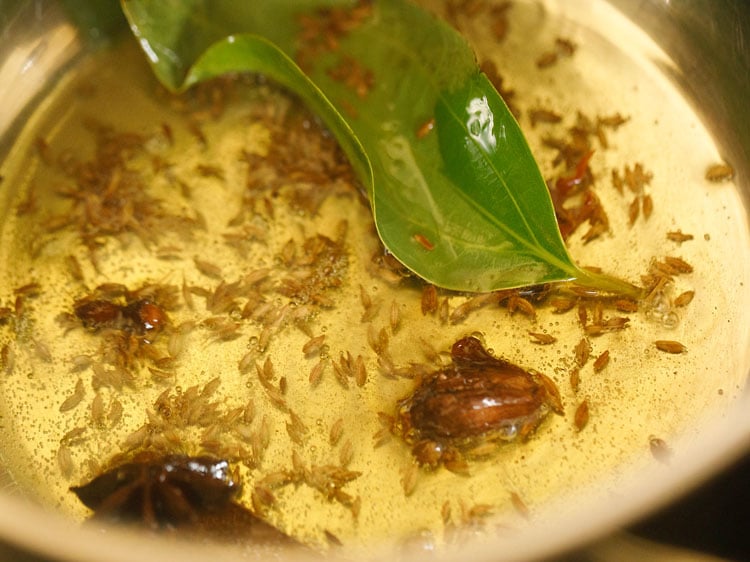
9. Add 1 cup of thinly sliced onions.
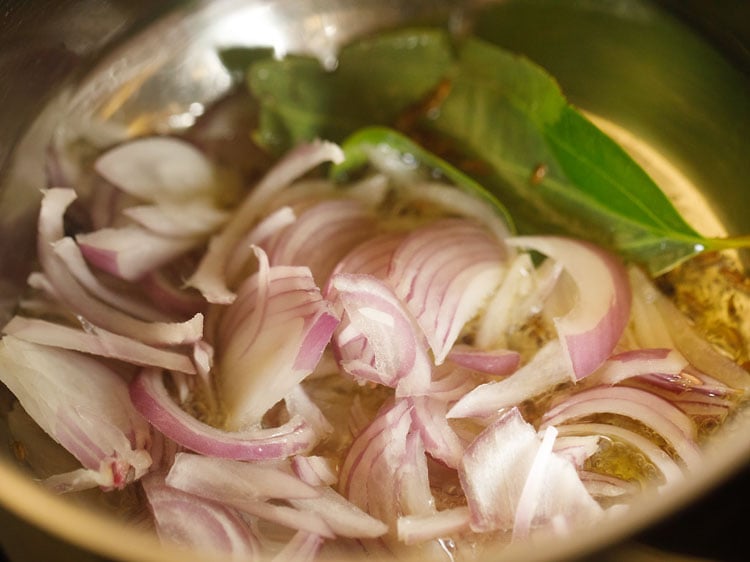
10. Mix the onions with the ghee and begin to sauté them.
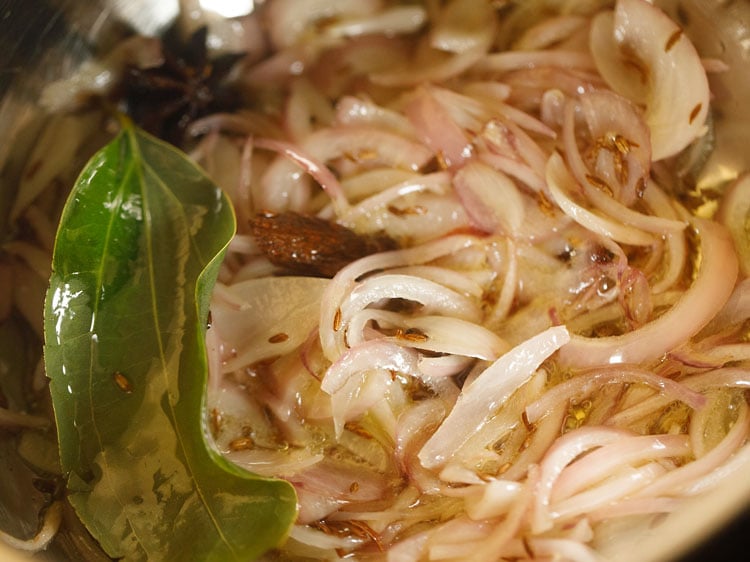
11. Sauté the onions on a low to medium-low heat. First, the onions will become light golden. Stirring often continue to sauté.
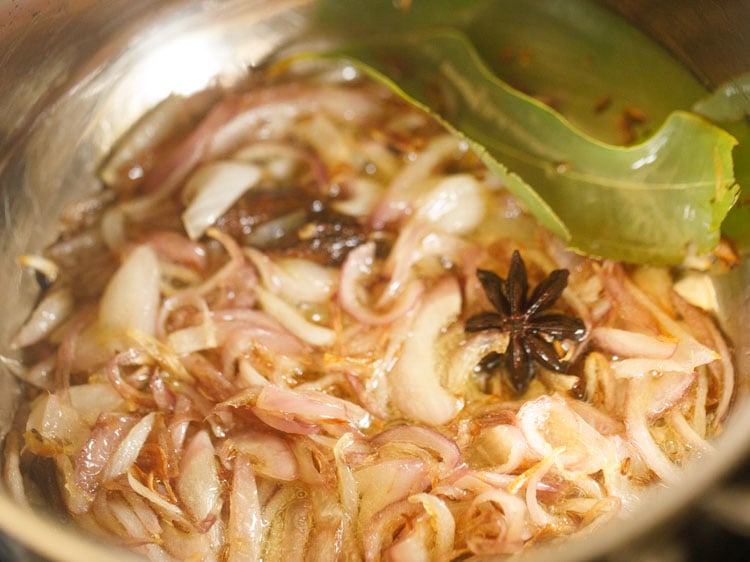
12. Sauté onions until golden.
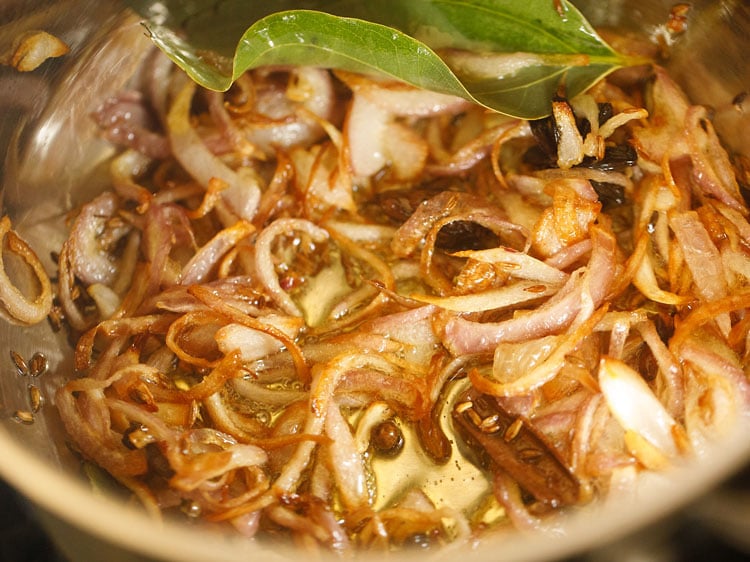
13. Once the onions become golden, add the crushed ginger + garlic + green chili (chili pepper) paste.
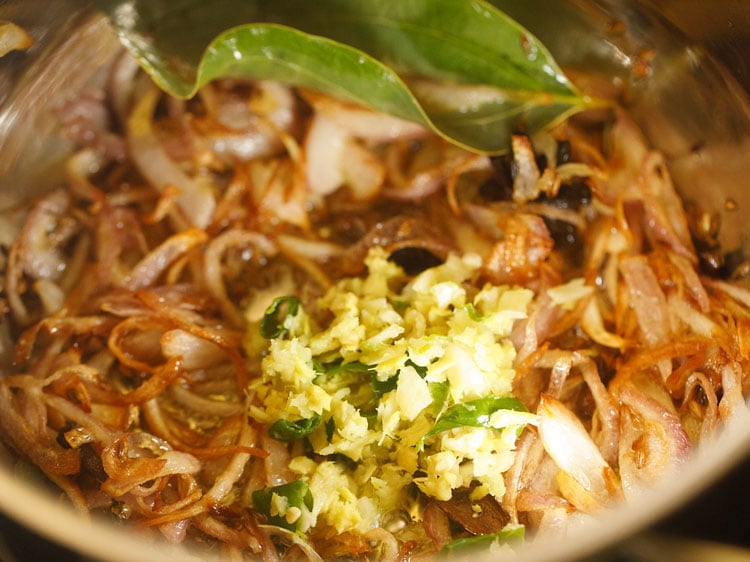
14. Stir and sauté for some seconds until the raw aroma of the ginger and garlic goes away.
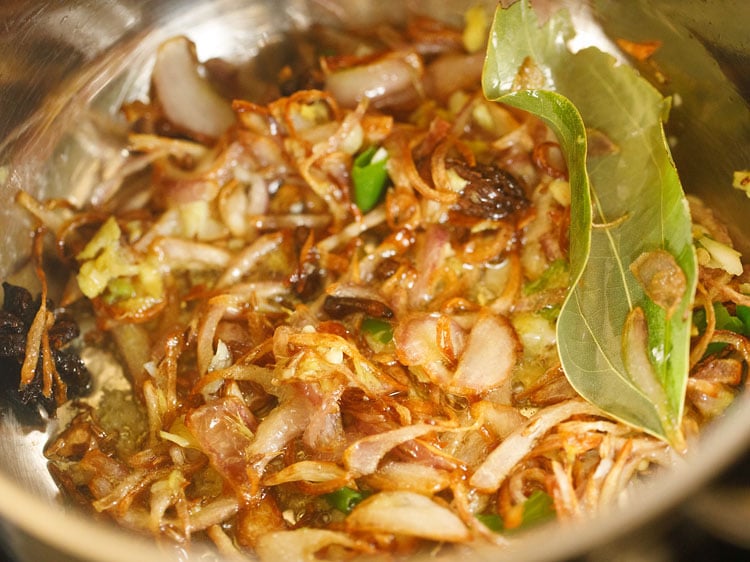
15. Add ½ cup chopped tomatoes.
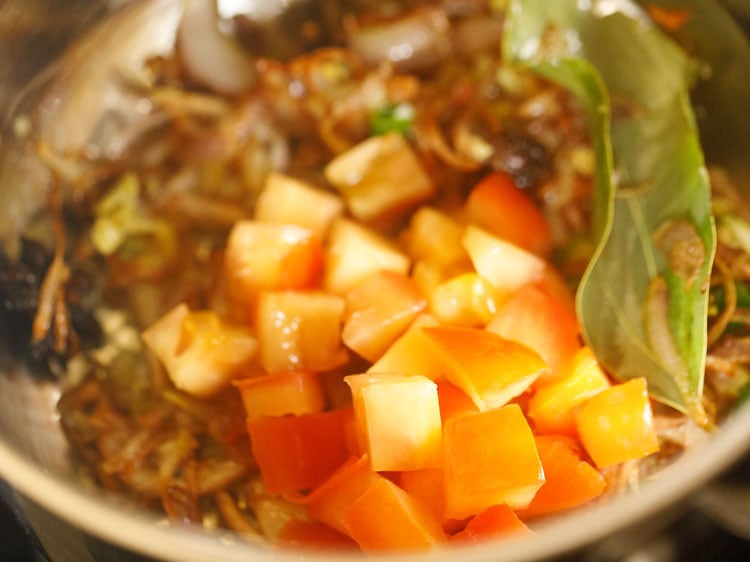
16. Mix and sauté for 2 to 3 minutes on a low heat.
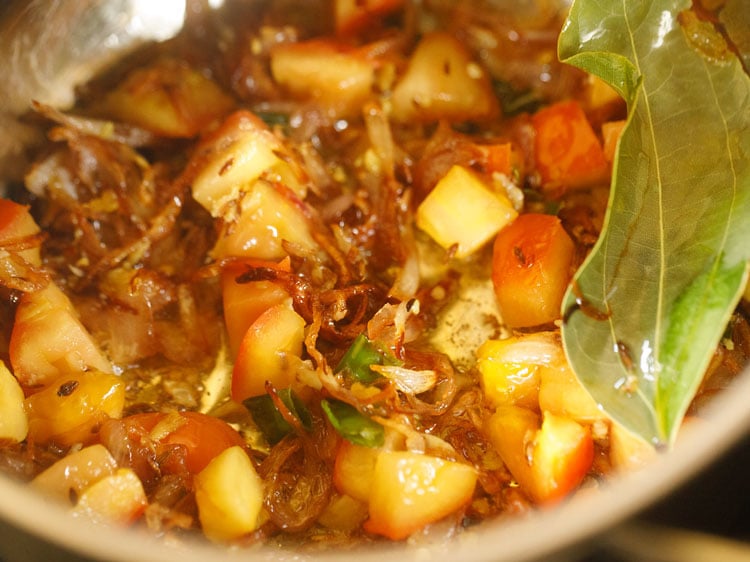
17. Now add all the chopped veggies. You can add about 1.5 to 2 cups of mixed chopped vegetables. Also add ⅓ cup of green peas (fresh or frozen).
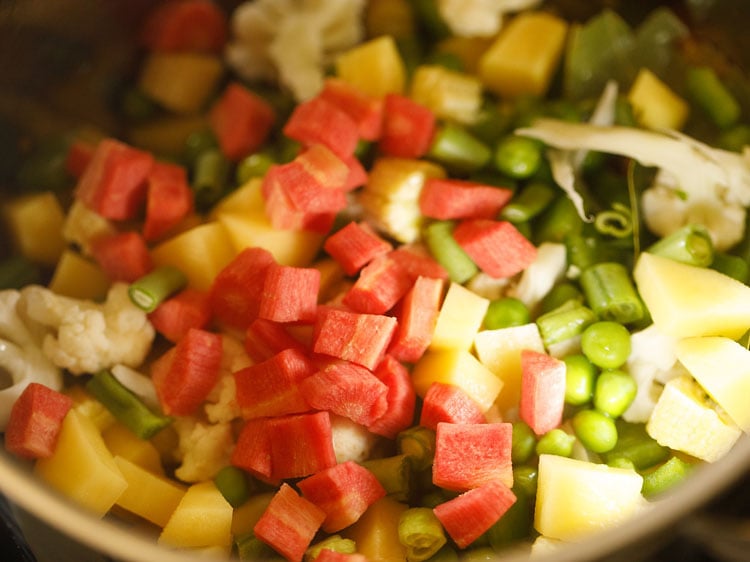
18. Add 2 to 3 tablespoons of chopped coriander leaves (cilantro). At this step, you can also add 2 tablespoons of chopped mint leaves.
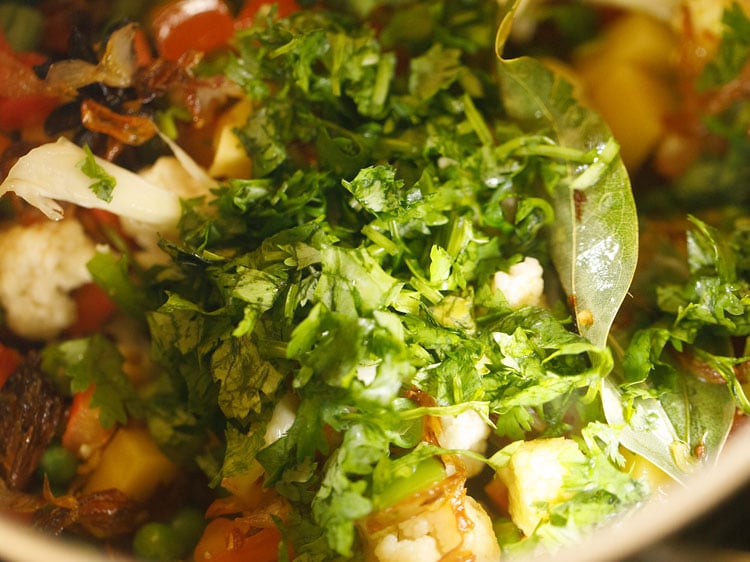
19. Mix and sauté again for 2 to 3 minutes on a low heat.
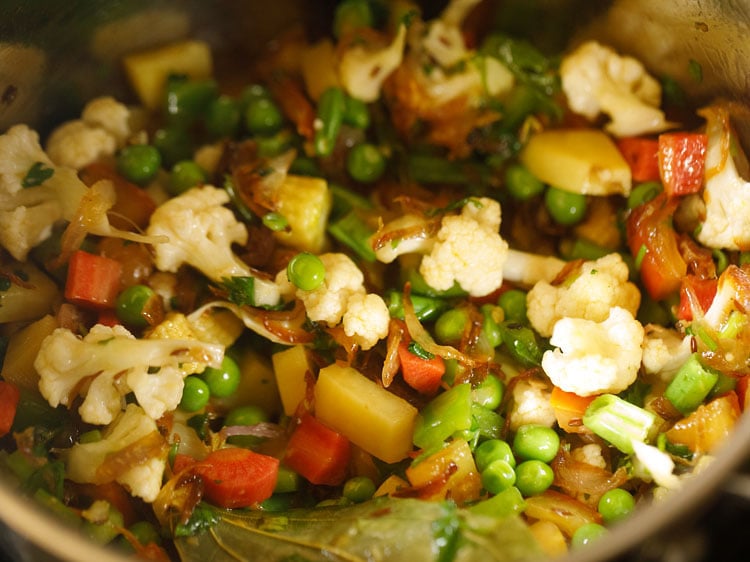
20. Add the soaked rice.
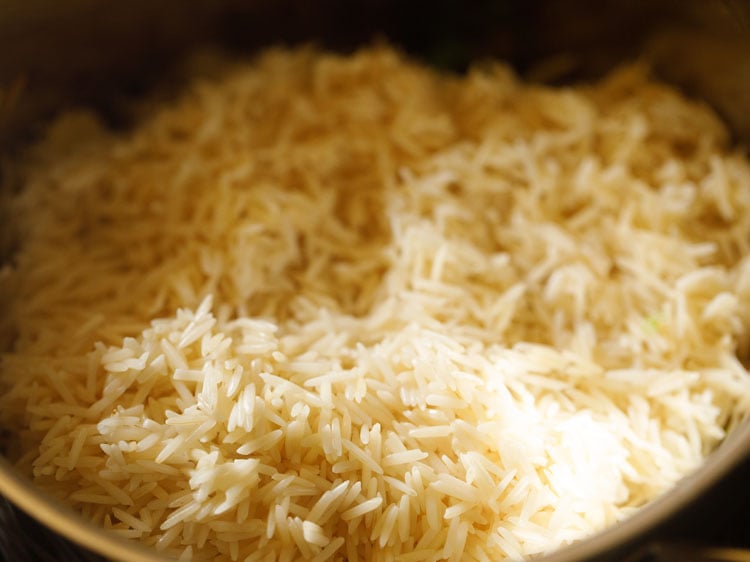
21. Mix rice gently with the rest of the ingredients.
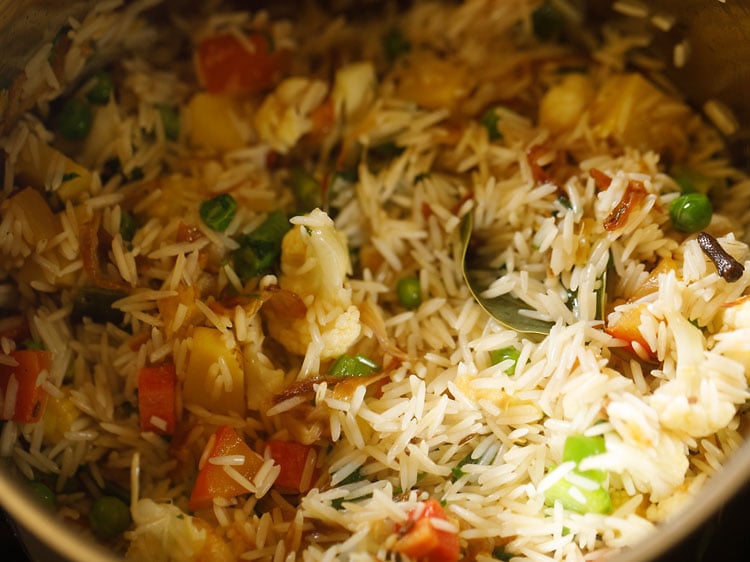
22. Sauté rice gently for 1 to 2 minutes on a low to medium-low heat, so that the rice grains get evenly coated with the oil or ghee.
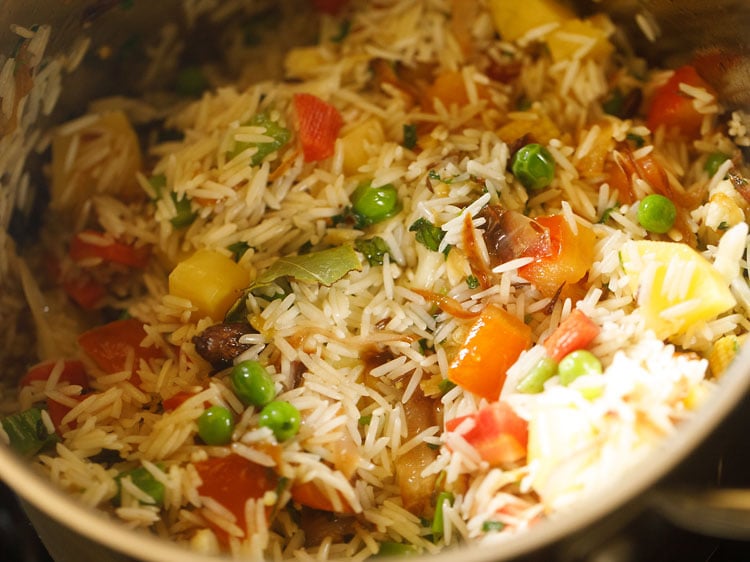
23. Pour 2.5 to 3 cups water into the pan. I added 3 cups of water. Depending on the quality of rice you have used, you can add less or more water. You can opt to replace water with vegetable stock.
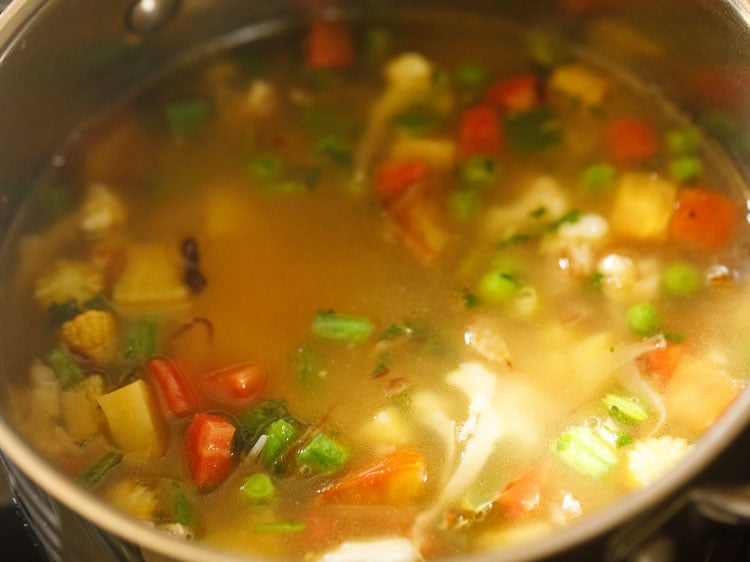
24. Add ¼ teaspoon lemon juice.
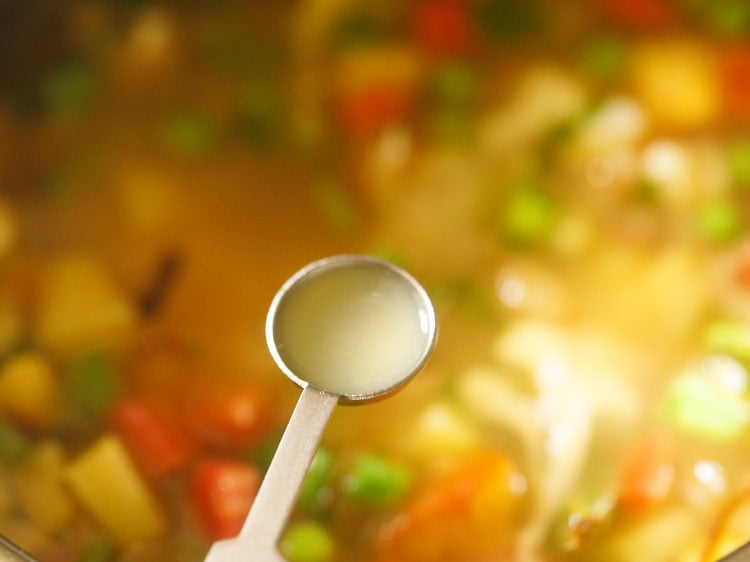
25. Season with salt. Mix very well. To figure out if you have added the right amount of salt, check the taste of the water. You should feel some saltiness in the water.
This means the amount of salt added is right. If the water does not feel salty, then you need to add some more salt.
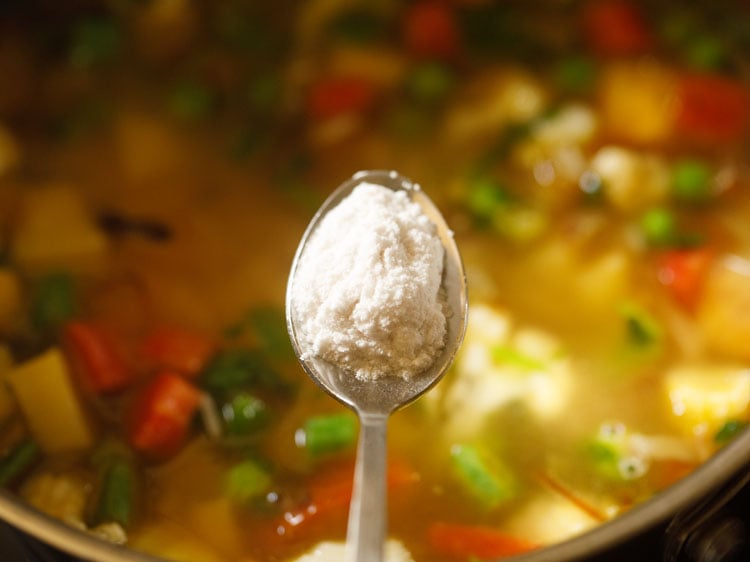
Cook Pulao
26. Stir and tightly cover the pot or pan with its lid.
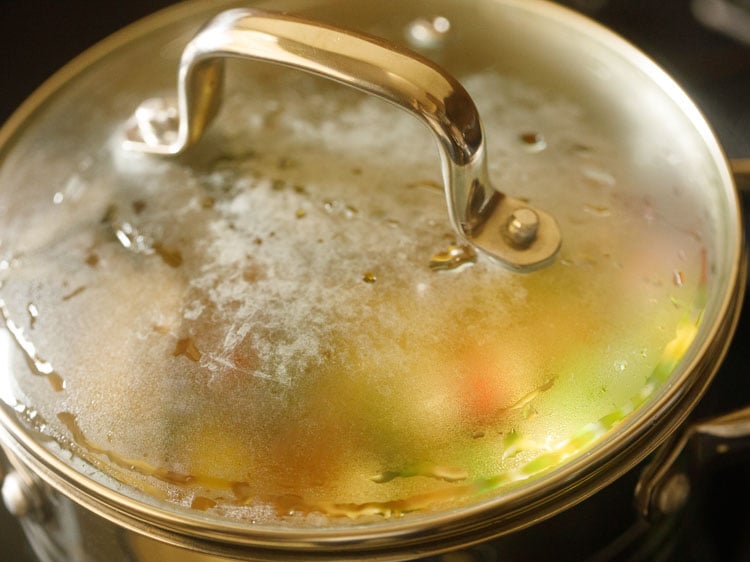
27. Cover and cook the rice until all the water is absorbed. Cook on a low to medium heat. Usually, in the beginning, I cook on a medium-low or medium heat and then halfway through, I lower the heat.
Check a few times during cooking to ensure there is enough water. Depending on the quality of rice, you may need to add more water. With a fork, you can also gently stir the rice without breaking the rice grains.
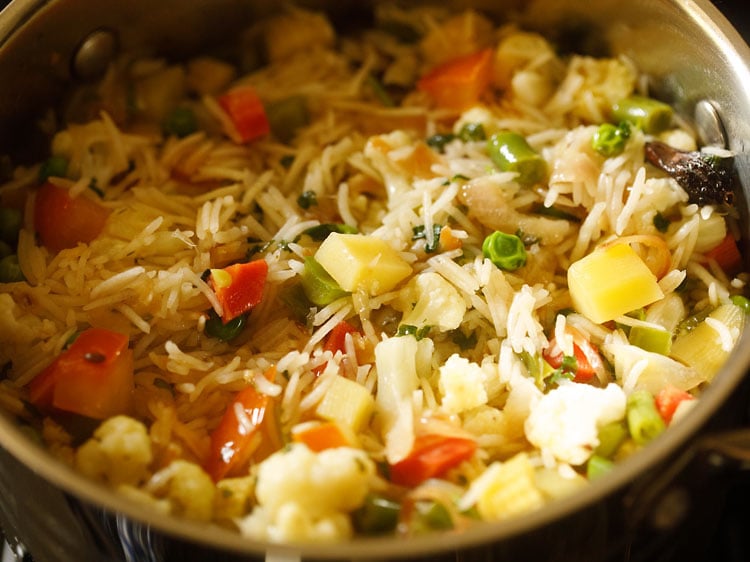
16. Once the rice grains are cooked, fluff them and let the rice stand for 5 minutes covered with the lid.
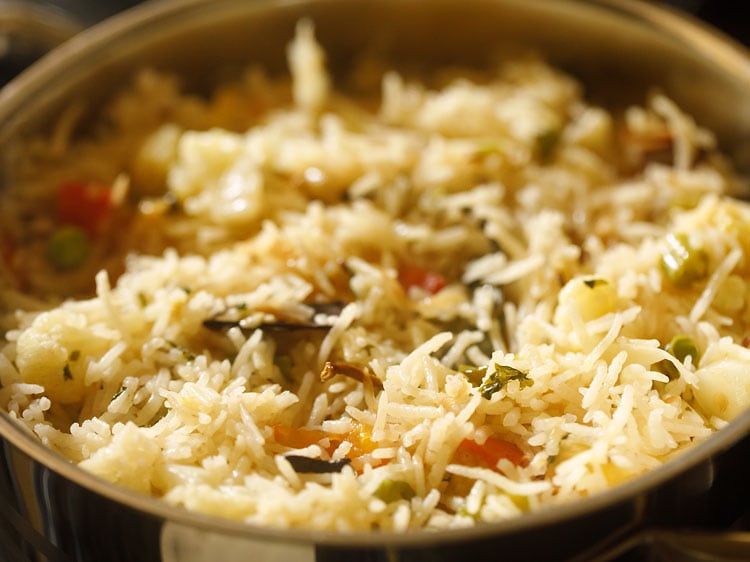
17. Serve Veg Pulao garnished with coriander leaves (cilantro), mint leaves or fried onions and fried cashews or fried raisins.
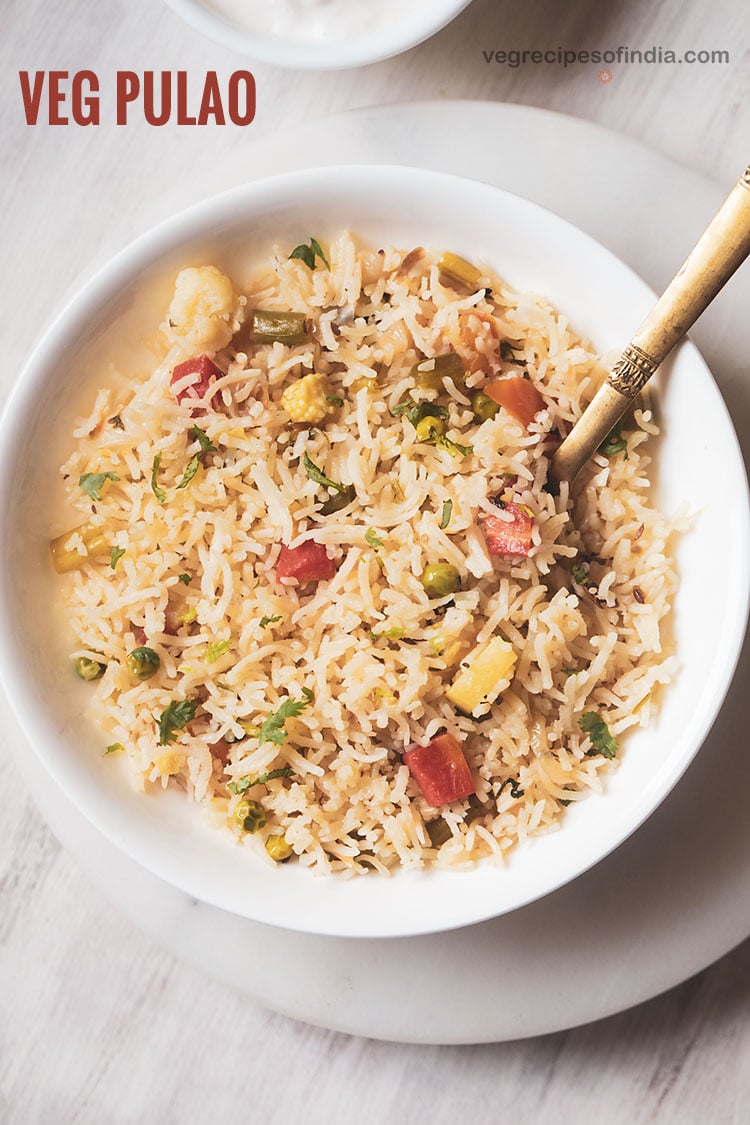
Serving Suggestions
I recommend serving vegetable pulao with the following sides:
- Raita (an Indian yogurt dish): Different variations I recommend include onion tomato raita, boondi raita or cucumber raita
- Curry or korma: Choose any spicy or lightly spiced vegetable curry or korma.
- With pickle and papad: If you do not have time or ingredients to make korma or raita, then just serve with some pickle and roasted or fried papad (an Indian flatbread)
- Plain curd (yogurt)
- Some sliced onions and lime or lemon
- A simple Kadhi (a dish of thick chickpea flour gravy with vegetable fritters)
Expert Tips
The most important thing in a pulao dish is that the rice grains are cooked perfectly without sticking or becoming mushy. The rice grains should be separate and non-sticky after being cooked.
Below you will find some expert tips and suggestions to help you prepare the perfect rice for your pulao.
Type and quality of rice
- Basmati rice is usually used to make pulao. The basmati rice should be fragrant and long-grained to get good results. Aged basmati rice will give you the best results.
- You can also use other types of long-grained rice and short-grained Indian rice varieties like seeraga samba, sona masuri or ambe mohar. These rice varieties can often be purchased on Amazon.
- In some parts of Tamil Nadu and Kerala (Southern Indian states), seeraga samba rice is widely used to make pulao and biryani.
- Even parboiled basmati rice (sella basmati) can be used to make this recipe.
Sticky rice vs. fluffy rice
Now that you have the correct rice, follow these steps to ensure you have fluffy separate rice grains in your pulao:
- Soak the rice – It is always better to soak your rice for 20 to 30 minutes before cooking. Soaking rice grains gives them a better texture when they are cooked. If you do not have time to soak them, then just rinse the rice before adding it. Note that if you only rinse the rice, you will need to add some more water as presoaked rice grains require less water for cooking as compared to rice grains which are not soaked.
- Add the right amount of water – Be sure that you do not add too much water, especially if you have presoaked your rice as recommended above.
- Sauté the rice – After adding the rice grains to your pan, sauté them for 1 to 2 minutes on a low to medium heat, so that they are coated with fat (oil or ghee). The rice grains have to be separate & and yet well cooked in a pulao or biryani. Adding lemon juice also helps make the rice grains fluffier.
Rice to water ratio
For most rice varieties, the rice to water ratio is generally 1:2. However, this ratio can vary depending on the particular type of rice used or the cooking method used:
- Example 1 – organic basmati rice requires more water while cooking and parboiled basmati rice will need more water as compared to regular basmati rice. For this reason, I recommend when cooking pulao, to use rice which you have cooked before. This way you will already know how much water to add.
- Example 2 – when cooking pulao in a stovetop pressure cooker, generally less water is added. The steam generated in the cooker helps in cooking the rice grains. However, the amount of water to be added will depend upon the size of the cooker. For example, in larger cookers, more water has to be added.
Pulao Variations
There are many variations that can be made in a pulao recipe. From adding different vegetables to using a vegetable stock or spicing with unique spices. See the points mentioned below.
Vegetables
Various types of vegetables can be added in a pulao, either alone or in a combination of two to three or more, depending on what you and your family like and prefer. Usually, a vegetable pulav is made with veggies like green peas, cauliflower, french beans, carrots, and potatoes.
Apart from these vegetables, you can also add broccoli, zucchini, mushrooms, capsicum (bell peppers), cabbage, beetroot (beets), and tomatoes. The flavors and taste of pulao will vary with the type of vegetables added to it.
Masala and Spice Pastes
There are many pulao varieties made in the Indian cuisine with a mix of various masala or spice pastes and ingredients including:
- Curd (yogurt)
- Coconut milk: for example Coconut milk pulao or Brinji rice
- Green Masala Paste: Green pulao includes a green masala paste made from coriander leaves (cilantro), mint leaves, green chilies (chili pepper), ginger and garlic. Some fresh coconut can also be added. Green pulao is similar to chutney pulao.
- Red Masala Paste: Used in making red pulao and similar to green masala paste, however tomatoes are used as one of the major flavor and taste contributors.
- Pulao-biryani masala: A ground spice blend used instead of whole spices.
- Vegetable Stock: Some pulav recipes are cooked in vegetable stock instead of water. Pulao made in a vegetable stock has a different taste and color.
- Spices and Herbs: You can always alter the amount of spices and herbs as per your taste. If you like spicy veg pulao then you can add more green chilies (chili pepper) and include some spice powders like garam masala powder or red chili powder. You can also reduce the whole spices in the recipe (except cumin) if you want a less aromatic and milder veg pulao.
Making Restaurant Style Pulao
A vegetable pulao can be made more delicious and similar to a restaurant-style dish by incorporating the following methods:
- Add some crisp golden fried onions (birista) as a garnish on the vegetable pulao. Fried caramelized onions not only taste good but also give a nice crunch in the soft textured pulao.
- Add some fried dry fruits & nuts like cashews, almonds and raisins.
- You can even add some saffron strands while cooking pulao. This will impart the lovely saffron aroma and flavor in the pulao. Even rose water or kewra water can be added.
Methods of cooking pulav
Pulao can be cooked in five ways:
- In a pan or pot (as shown in this recipe post)
- In a Pressure Cooker
- Using an Instant Pot
- In an electric cooker
- In a microwave oven
You can use any of the above methods for cooking pulao, but just remember to add the correct amount of water. For example, in an electric cooker, you will need to add more water and in a pressure cooker you will need to add less water.
More Tasty Pulao Recipes
Rice Recipes
Rice Recipes
Paneer Recipes
Rice Recipes
Please be sure to rate the recipe in the recipe card or leave a comment below if you have made it. For more vegetarian inspirations, Sign Up for my emails or follow me on Instagram, Youtube, Facebook, Pinterest or Twitter.
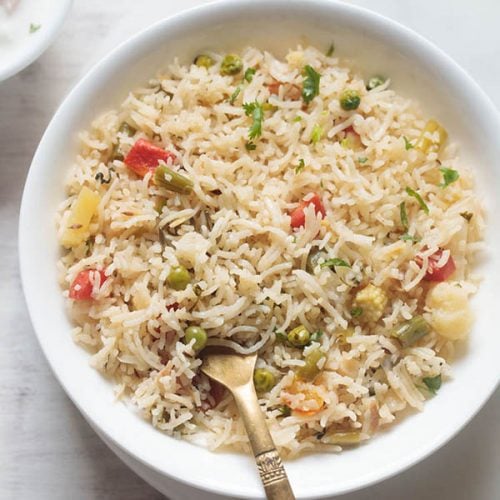
Pulao Recipe | Veg Pulao | Pulav
Trying to get more vegetables in your diet? Try this vegetarian one pot meal of Pulao or Pulav. Use the vegetables that you like most, like peas, potatoes, and green beans. Make this simple Veg Pulao recipe that packs a punch of flavor!
Prep Time 15 mins
Cook Time 25 mins
Total Time 40 mins
Prevent your screen from going dark while making the recipe
Preparation
Rinse rice till the water runs clear of starch and become transparent while rinsing.
Soak the rice in enough water for 20 to 30 minutes. Drain all the water and keep the soaked rice aside.
Rinse, peel and chop the vegetables.
Crush chopped ginger, garlic and green chillies to a paste in a mortar-pestle or grind them in a small mixer or grinder with a bit of water.
Frying spices and sautéing onions
In a deep thick bottomed pot or pan, heat ghee or oil and fry all the whole spices mentioned above, till the oil becomes fragrant and the spices splutter.
Add the onions and saute them till golden. Saute the onions on a low to medium-low heat and stir often for even browning.
Add the ginger-garlic-green chili paste and saute for some seconds till their raw aroma goes away.
Add the tomatoes and sauté for 2 to 3 minutes on a low to medium-low heat.
Add all the chopped veggies, green peas and sauté again for 1 to 2 minutes on a low to medium-low heat.
Add rice and sauté gently for 1 to 2 minutes on a low or medium-low heat, so that the rice gets well coated with the oil.
Add water and lemon juice. Mix and stir.
Season with salt and stir again.
Making Vegetable Pulao
Cover tightly and let the rice cook on a low heat, till the water is absorbed and the rice is well cooked.
- Check in between a few times to check if the water is enough. Depending on the quality of rice, you may need to add less or more water. With a fork too, you can gently stir the rice without breaking the rice grains.
Once the rice grains are cooked, fluff and let the rice stand for 5 minutes.
Serve pulao hot with some side salad, sliced onion and lemon wedges or raita. You can also garnish it with chopped coriander or mint leaves or fried cashews or fried onions.
- Type and quality of rice: Pulao is always made with Basmati rice. The basmati rice should be fragrant and long-grained to get good results. Aged basmati rice will give you the best results. Even parboiled basmati rice (sella basmati) can be used. You can also use other types of long-grained rice and short-grained rice. These Indian rice varieties can be easily purchased from Amazon.
- For separate rice grains: Follow these steps to ensure you have separate rice grains in your pulao:
- Soak the rice: It is always better to soak your rice for 20 to 30 minutes before cooking. Soaking rice grains gives them a better texture when they are cooked. If you do not have time to soak them, then just rinse the rice before adding it. Note that if you only rinse the rice, you will need to add some more water as presoaked rice grains require less water for cooking as compared to rice grains which are not soaked.
- Add just enough water: Be sure that you do not add too much water, especially if you have presoaked your rice as recommended above.
- Sauté the rice: After adding the rice grains to your pan, sauté them for 1 to 2 minutes on a low to medium flame, so that they are coated with fat (oil or ghee). The rice grains have to be separate & and yet well cooked in a pulao or biryani. Adding lemon juice also helps make the rice grains fluffier.
- Rice to water ratio: For most rice varieties, the rice to water ratio is generally 1:2. However, this ratio can vary depending on the particular type of rice used or the cooking method used:
- Example 1– organic basmati rice requires more water while cooking and parboiled basmati rice will need more water as compared to regular basmati rice. For this reason, I recommend when cooking pulao, to use rice which you have cooked before. This way you will already know how much water to add.
- Example 2– when cooking pulao in a pressure cooker, generally less water is added. The steam generated in the cooker helps in cooking the rice grains. However, the amount of water to be added will depend upon the size of the cooker. For example, in larger cookers, more water has to be added.
- Vegetables: You can add your favorite vegetables. Note that the vegetables add a lot of flavor to the rice. You can even add mushrooms to a give a meaty texture and umami flavor to the pulao. Button Mushrooms, morel mushrooms, cremini mushrooms, shiitake mushrooms can be added.
Nutrition Facts
Pulao Recipe | Veg Pulao | Pulav
Amount Per Serving
Calories 429 Calories from Fat 99
% Daily Value*
Fat 11g17%
Saturated Fat 6g38%
Polyunsaturated Fat 1g
Monounsaturated Fat 3g
Cholesterol 25mg8%
Sodium 68mg3%
Potassium 501mg14%
Carbohydrates 75g25%
Fiber 6g25%
Sugar 5g6%
Protein 9g18%
Vitamin A 1839IU37%
Vitamin B1 (Thiamine) 1mg67%
Vitamin B2 (Riboflavin) 1mg59%
Vitamin B3 (Niacin) 2mg10%
Vitamin B6 1mg50%
Vitamin C 32mg39%
Vitamin E 1mg7%
Vitamin K 11µg10%
Calcium 74mg7%
Vitamin B9 (Folate) 46µg12%
Iron 3mg17%
Magnesium 51mg13%
Phosphorus 149mg15%
Zinc 1mg7%
* Percent Daily Values are based on a 2000 calorie diet.
This Veg Pulao recipe from the archives first published in November 2014 has been republished and updated on November 2022.
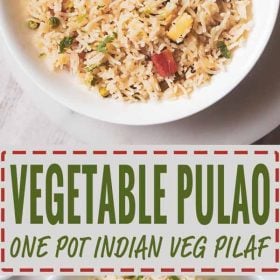
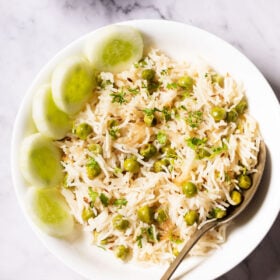
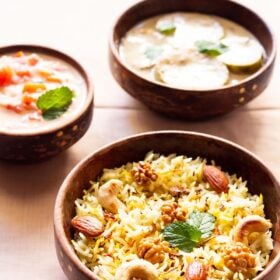
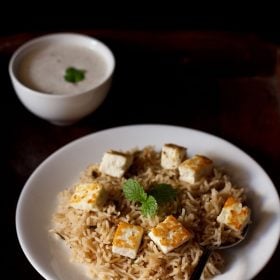
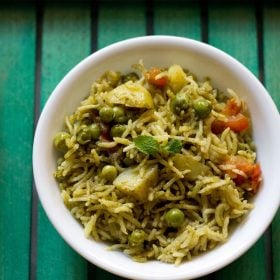






0 Comments